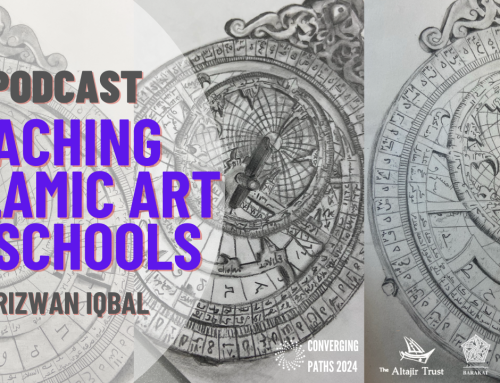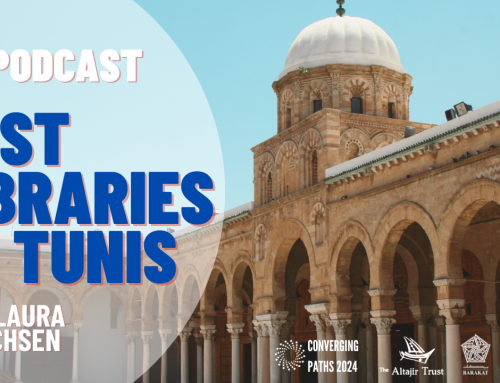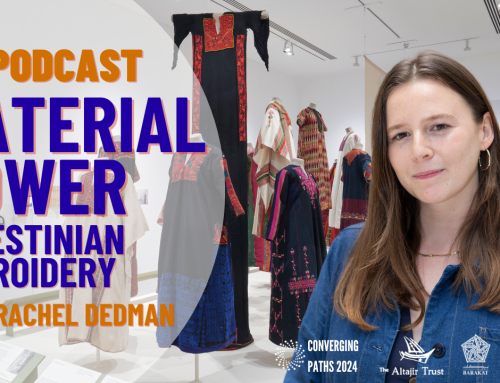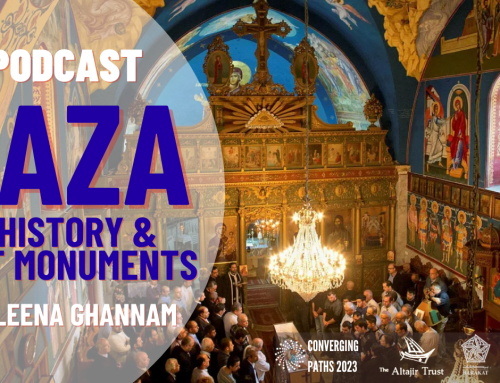Grantee: Hallie Nell Swanson
In summer 2019, with the support of The Barakat Trust’s Barakat Postgraduate Student & Early Career Award, I travelled to Hyderabad to take part in the “Working in an Indian Archive” Indo-Persian Summer School, a workshop focused on reading Indo-Persian manuscripts, run by the University of Gottingen and the Lal Bahadur Shashtri Centre, Tashkent, and hosted by Maulana Azad National Urdu University (MANUU). Our group of 25 students, drawn from across India, the US, and Europe, plus participants from MANUU’s Persian MA and PhD programmes, spent two weeks familiarizing ourselves with the conventions of Persian manuscripts from the Mughal period, through classes at MANUU and visits to the Telangana State Archives.
This was an important experience for me to train in manuscript studies in preparation for my PhD in Religious Studies at the University of Pennsylvania, where I focus on early modern Indo-Persian literary and material culture, and its relationship to Islamic ethics. Focusing on the seventeenth to nineteenth centuries entails a strong background in the language and paleographical conventions of Mughal Persian, which has its own vocabulary (much closer to how words are used in Urdu than in the modern Iranian Persian usually taught today), formulaic stylistic conventions, and script (frequently shikastah or nastaliq, rather than the naskh usually used in print texts today).
The summer school enhanced my ability to examine and analyse manuscripts at the material level, helping me to understand what kinds of technologies in paper and binding, and what kind of scribal work, served to circulate literary texts during an explosion of paper production and increased literacy and institutional use of books during the late Mughal period. I also became familiar with the calligraphy used for Indo-Persian, which differed substantially from standard forms as scribes worked rapidly in their own bureaucratic shorthands, forming special shorthand symbols for certain common Persian constructions (as with words like ‘ke’, ‘do’ and ‘ra’) and not differentiating between certain letters (leaving the dots off of Peso-Arabic letters, rendering them ambiguous). For these reasons, the course was essential for fulfilling my goals for future research.
The archives’ staff know how these different documents relate to each other and intuitively understand material aspects that offer important context and valuable clues: for example, many of us were shocked to see the sheer size of a massive farman after seeing them on screens and printouts and imagining them to be roughly A4. People who know the archives can date and locate them simply by looking at them; a task much harder when one is trying to decipher dates on a screen. The summer school was thus aimed at not only training us to read Indo-Persian texts through classes, workshops and homework, but also exposing us to physical texts and the archival context of the State Archives.
We spent the first few days of the program learning to read the scripts common in Mughal administration, Nasta’liq and Shekasteh, for preparation using them later as we worked with primary texts. The shekasteh script, best understood as the ‘cursive’ Perso-Arabic script, is especially difficult, defined by the joining of letters in eccentric ‘loops’ which have to be memorized. Professor Eva Orthmann from Gottingen provided us with important resources for our future study, compiling hard-to-find Orientalist guides to reading the scripts and giving us a thoughtful history of their use. Dr Ali Langroudi offered us some hands-on exercises, asking us to guess words without the use of dots to distinguish otherwise identical Persian letters (a common feature of manuscripts written in shekasteh). Our confidence improved, even if his initial module on the ‘looped’ joining of letters which are otherwise never joined provoked gasps of horror among the crowd. I was initially very intimidated, but since the workshop, I have found myself drawing on it to read eighteenth-century Indo-Persian letters as a research assistant.
After the script came the time to familiarize ourselves with conventional language. There was a unit on dates, covering the variety of calendars that might be used in the period: the Iranian solar calendar; Islamic calendar; and Mongol calendar, based on time periods denoted by particular animals. Complicating matters was the use of different years: the Hijri year and the monarch’s regnal year, which might have been counted using the solar calendar, depending on the monarch and the point in their reign. The fact that there were usually conventional formulae for introducing dates, however, offered us some handy clues which I have been able to use since: I have realized how the familiar curve identifying dates in later Urdu print texts comes from the Indo-Persian way to denote a year by underlining numbers with a cursive ‘sana’, or Arabic for ‘year’, making it easier to scan a text for dates where other numbers may be present.
Our session on Mughal seals and tughras (elaborate grid-like formations that functioned to guarantee the authenticity of an imperial communication) was similarly challenging and enjoyable. We were able to deploy knowledge of the various titles used by different monarchs, for example Shah Jahan’s famous identification as the sahib-e- qiran-e sani or second Lord of Conjunction (after his illustrious ancestor, Timur), and identify how different emperors and more petty princes used their seals to make claims to ancestral lineages. Learning to read these documents also meant learning a lot about how state bureaucracy worked: the direction of handwriting on the page of a farman, and the ordered placement of different seals and stamps, showed us how the large scroll would be rolled up and taken to different departments on its journey through the administration. The space on the verso side for further commentary about its journey, often written at an angle to the main body of the text on the recto, showed us the afterlife of these imperial directives.
We also learnt about siyaq numerals, a notation system used in accounting. Initially, the characters seemed completely indecipherable: it works on decimals, but rather than adding individual numerals to a different decimal place, extends a ‘word’ by a certain amount of space. Consequently, to the untrained eye (such as mine beforehand) they can look like strange, illegible words. While I am far from performing breezy siyaq calculations, since then, I have been able to identify siyaq when it comes up (for example, in accounting income calculations in the correspondence I have been looking at), rather than puzzling over it.
After figuring out these basic skills, we began dissecting the language of particular Indo-Persian genres: farmans, the arz-o chehre (a ‘head to toe’ description of a conscript), and texts by the Imperial waqai nevis, or ‘news writer’, who relayed information from the court to the provinces and vice versa. Learning certain formulae associated with each text made the task of interpreting them easier, and provided the cohort with its Whatsapp group chat name ‘be danand ke…’, or ‘let it be known [by them],’ a standard formula in farmans which followed a list of people to whom it was addressed. Professor Chander Shekhar from Delhi University led an especially exciting session on a waqai nevis source from the Aurangzeb period, concerning a case whereby a local official was accused of murdering a potter and abducting his wife. The group was transfixed over possible interpretations of what really might have happened. Being able to read the waqai nevis’s Mughal Persian opened up a fascinating picture of how governance and justice were understood at the local level.
After a few days’ practice, we were ready to transfer to the Telangana State Archives, which hold a large collection of official documents dating from the Mughal through to Nizami era. Finally getting to look at physical documents was a real treat: alongside factors like size and type of paper, we could observe differences in the kinds of pen and ink used between each era (by the Nizam’s time, the farmans were in beautiful clearly-articulated Nasta’liq, clearly serving a more ceremonial role). Divided into sub-groups, we were assigned different documents, pleasantly surprised as our skills of reading and translation had clearly improved after our initial orientation and subsequent practice. The archive opened up a fascinating collection of documents: the highlight was a several-meters long linear ‘map’ of the Grand Trunk Road between Lahore and Delhi, marking in Persian such landmarks as the rivers and Dara Shikoh’s house. This unconventional source opened up interesting questions for me about premodern conceptions of space. Maps are frequently described as being introduced to South Asia through colonial administration, but I wondered what kinds of other ways of imagining and picturing space we can see at work by analyzing understudied Mughal sources.
One highlight of the program was how it drew together students who work on a large variety of areas that have need of Indo-Persian sources, from perfume in the Mughal period to miniature painting to Yunani tib or Perso-Arabic medicine. I found myself constantly benefiting from the insights my more advanced colleagues had gained through their own archival experiences and their exposure not only to Mughal texts but also contemporary Safavid and Ottoman documents. Having students with a knowledge of many languages (including Arabic, Gujarati and Marathi) was also often helpful. As we worked together to decipher crunched-up abbreviations at the end of lines, or convert Hijri and regnal-year dates, we progressed together with each other’s help. It was a great experience for me as I prepared to enter the first year of my PhD program. I felt I left with a greater knowledge of what field work in archival contexts in South Asia will entail, including many challenges but also the potential to develop strong relationships with a wide range of colleagues. We have kept in touch, and I hope we keep running into each other as we continue in this field.
Finally, being in Hyderabad was truly exciting: a trip the programme arranged to the Qutb Shahi tombs, where we were toured around by a representative from the Aga Khan Foundation who is renovating the site, was especially exciting, and the group excitedly went about reading Persian and Arabic inscriptions on gravestones. We also went to a shrine, the dargah of Hazrat Patthar Wale Sahib, where we explored their library of rare Persian and Urdu books and periodicals, and listened to qawwali in Persian. On my own excursions around the city, I tested my Persian knowledge reading inscriptions at the impressive Qutb Shahi fort and beautiful Paigah Tombs.
The study of Indo-Persian material texts is important for several reasons. The structure of regional studies in the US and Europe tends to segment the study of the Middle East and South Asia, conflating Persian – once a cosmopolitan lingua franca across what Shahab Ahmed has called the ‘Balkans-to-Bengal complex’ – with the borders of modern Iran. This has the further damaging effect of compounding the perception that Persian and Urdu are ‘outsider’ languages in India, and cultural production in these languages was somehow inauthentically Indian, being only by or for Muslim ‘invaders’. This, combined with Iran’s claim to being the home of Persian, can render Indo-Persian texts “homeless,” as some scholars (Mana Kia, Mohamed Tavakoli-Targhi) have called them. The state of many Persian archives in India is also precarious due to a combination of factors: government under-funding; lack of facilities for climate control and preservation; and the fact that Persian literacy is not widespread among non-specialists. Rajeev Kinra has called this situation “such a musty linguistic and archival purgatory that [Indo-Persian texts] are barely even available to be read any more.” The summer school was designed against this background with the aim of training a generation of young scholars to help use these texts in their work.
Digitisation efforts by bodies like the British Library and the University of Bamberg’s asnad.org project have made progress in preserving these valuable archives. However, something is also lost when these manuscripts are consumed simply on a screen: the materiality of the texts and what this can tell us about their contexts of creation and consumption, and their particular institutional situation in the archives, whose collections and principles of organization can inform us about their histories. For example, the Telangana State Archives host so many Aurangzeb farmans because of his campaigns in the Deccan; these were archived along with the archives from the legacy Asaf Jahi dynasty up to its last Nizam of Hyderabad; the archives stayed when the new state of Telegu-speaking Telangana was carved out of the former state of Andhra Pradesh, as the city remained the capital of both.
Since the summer program, I have continued reading Indo-Persian texts through my coursework and gaining greater exposure to eighteenth-century Indo-Persian manuscripts through working as a research assistant, as well as conducting my own research through fellowships at the Roshan Institute for Persian Studies and Schoenberg Institute for Manuscript Studies. All this would have been much harder without the valuable experience offered by the summer school. I am immensely grateful for the Barakat Trust’s grant for enabling me to have this invaluable experience.






